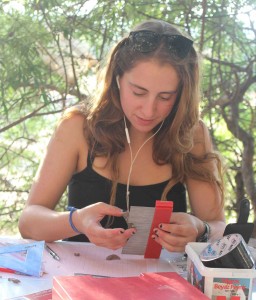(guest post by Sarah Wilker)
Underwater excavations are, by definition, quite wet. From wet suits to water dredges, most excavation work is done entirely submerged. Yet while excavation itself is water based, artifact cataloguing and processing is a much drier experience. This summer I have been able to experience this drier side of the excavation by working almost entirely with the excavated pottery. The work includes but is not limited to desalinating pottery, sorting sherds by usage and fabric, and drawing and taking photos of diagnostic pieces. When working with the pottery, my main tasks are fabric sorting and drawing, two jobs that have afforded me a strikingly bifurcated view of the ceramics coming out of the trenches. While fabric sorting provides a broad picture of more of the pottery, drawing individual diagnostic finds compels a much narrower focus.
Fabric sorting is the process by which we separate sherds into groups based on their respective clay fabric. This fabric sorting focuses mainly on the amphora fragments. When fabric sorting pieces of amphoras, I clip a small piece off of each sherd, in order to expose the fabric of the piece. While the fabric is somewhat visible on the surface of the piece, it is difficult to accurately discern because of the sherd’s exposure to salt water over an extended period of time. Over the past several years, we have used both qualitative analysis and XRF analysis to figure out which fabrics come from local workshops, and which fabrics can be classified as imports. Through this analysis, we can learn more about both ceramic production and trade in the area. Fabric sorting affords me a very wide angle view of the ceramics being excavated. As I look more at groups of sherds than individual pieces, I can see general patterns in the pottery as a whole.
Pottery drawing, on the other hand, allows for a much narrower perspective on the excavated ceramics. After the sherds have been desalinated and dried, diagnostic sherds are selected for drawing and photography. Diagnostic sherds have an identifying feature, like a rim or a base, that allows them to be linked to a specific type of vessel and dated to a specific time period. While photography only shows a piece of pottery the way it is now, drawing can help illustrate the way a particular ceramic form once looked, by showing the diameter, profile, and all visible contour lines. Unlike the broader lens of fabric sorting, pottery drawing enables me to see individual diagnostic pieces in great detail, and gives me a sense of individual finds rather than the whole assemblage.
While my activities this season on the Burgaz Harbors Project may not be typical of an underwater archaeology experience, being submerged in the pottery has allowed me a new vantage point on the excavation, and given me a better understanding of the material uncovered in the field.


